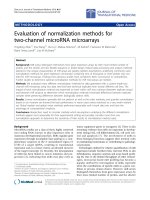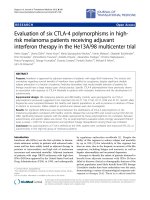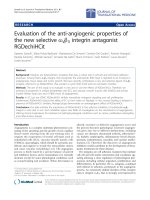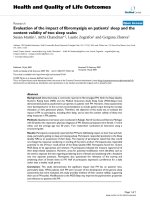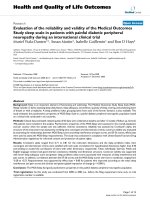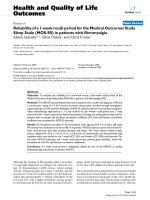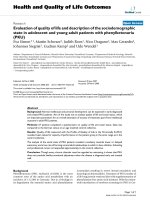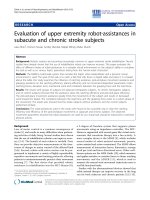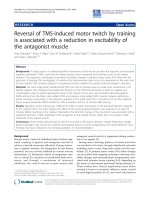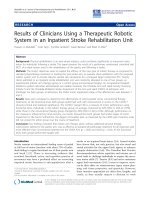báo cáo hóa học: " Evaluation of the reliability and validity of the Medical Outcomes Study sleep scale in patients with painful diabetic peripheral neuropathy during an international clinical trial" pot
Bạn đang xem bản rút gọn của tài liệu. Xem và tải ngay bản đầy đủ của tài liệu tại đây (582.27 KB, 12 trang )
BioMed Central
Page 1 of 12
(page number not for citation purposes)
Health and Quality of Life Outcomes
Open Access
Research
Evaluation of the reliability and validity of the Medical Outcomes
Study sleep scale in patients with painful diabetic peripheral
neuropathy during an international clinical trial
Muriel Viala-Danten*
1
, Susan Martin
2
, Isabelle Guillemin
1
and Ron D Hays
3
Address:
1
Mapi Values, 19 rue de la Villette, 69003 Lyon, France,
2
Pfizer, 2800 Plymouth Road, Ann Arbor, MI 48105, USA and
3
UCLA Department
of Medicine/Division of General Internal Medicine & Health Services Research, 911 Broxton Avenue, Room 110, Los Angeles, CA 90024-2801,
USA
Email: Muriel Viala-Danten* - ; Susan Martin - ; Isabelle Guillemin - ;
Ron D Hays -
* Corresponding author
Abstract
Background: Sleep is an important element of functioning and well-being. The Medical Outcomes Study Sleep Scale (MOS-
Sleep) includes 12 items assessing sleep disturbance, sleep adequacy, somnolence, quantity of sleep, snoring, and awakening short
of breath or with a headache. A sleep problems index, grouping items from each of the former domains, is also available. This
study evaluates the psychometric properties of MOS-Sleep Scale in a painful diabetic peripheral neuropathic population based
on a clinical trial conducted in six countries.
Methods: Clinical data and health-related quality of life data were collected at baseline and after 12 weeks of follow-up. Overall,
396 patients were included in the analysis. Psychometric properties of the MOS-Sleep were assessed in the overall population
and per country when the sample size was sufficient. Internal consistency reliability was assessed by Cronbach's alpha; the
structure of the instrument was assessed by verifying item convergent and discriminant criteria; construct validity was evaluated
by examining the relationships between MOS-Sleep scores and sleep interference and pain scores, and SF-36 scores; effect-sizes
were used to assess the MOS-Sleep responsiveness. The study was conducted in compliance with United States Food and Drug
Administration regulations for informed consent and protection of patient rights.
Results: Cronbach's alpha ranged from 0.71 to 0.81 for the multi-item dimensions and the sleep problems index. Item
convergent and discriminant criteria were satisfied with item-scale correlations for hypothesized dimensions higher than 0.40
and tending to exceed the correlations of items with other dimensions, respectively. Taken individually, German, Polish and
English language versions had good internal consistency reliability and dimension structure. Construct validity was supported
with lower sleep adequacy score and greater sleep problems index scores associated with measures of sleep interference and
pain scores. In addition, correlations between the SF-36 scores and the MOS-Sleep scores were low to moderate, ranging from
-0.28 to -0.53. Responsiveness was supported by effect sizes > 0.80 for patients who improved according to the mean sleep
interference and pain scores and clinician and patient global impression of change (p < 0.0001).
Conclusion: The MOS-Sleep had good psychometric properties in this painful diabetic peripheral neuropathic population.
Trial registration: As this study was conducted from 2000 to 2002 (i.e., before the filing requirement came out), no trial
registration number is available.
Published: 17 December 2008
Health and Quality of Life Outcomes 2008, 6:113 doi:10.1186/1477-7525-6-113
Received: 19 May 2008
Accepted: 17 December 2008
This article is available from: />© 2008 Viala-Danten et al; licensee BioMed Central Ltd.
This is an Open Access article distributed under the terms of the Creative Commons Attribution License ( />),
which permits unrestricted use, distribution, and reproduction in any medium, provided the original work is properly cited.
Health and Quality of Life Outcomes 2008, 6:113 />Page 2 of 12
(page number not for citation purposes)
Background
Sleep is an important element of functioning and well-
being and is associated with clinical status and general
health. Indeed, sleep problems have been found to be
associated with depression, anxiety, impaired social func-
tioning, hospitalizations, chronic medical conditions and
mortality [1-3]. A number of sleep questionnaires exist
that are designed either to measure different aspects of
sleep such as quality of sleep, to identify the impact of
sleep problems on daily functioning, or to evaluate the
impact of sleep disorders on patients' life [4-13].
Painful diabetic peripheral neuropathy (DPN) is one of
the most common complications of type I and type II dia-
betes. Painful DPN may affect sleep, work, social activities
and relations, physical mobility, levels of anxiety and
depression and energy [14-16], thus leading to the sub-
stantial impairments in patients' health-related quality of
life (HRQoL) [17,18]. Sleep disturbance is common in
chronic pain and is of particular concern in painful DPN
as it may influence the progression of type II diabetes [19].
A recent study confirmed the association of painful DPN
with sleep impairment [15].
The present study examines perceptions of sleep in an
international clinical trial aimed at evaluating the efficacy
and safety of the pregabalin, a treatment for pain relief in
patients with painful DPN. The Medical Outcomes Study-
Sleep Scale (MOS-Sleep) was administered to patients in
order to assess the impact of the pregabalin treatment on
patients' quality of sleep. We used the data from the inter-
national clinical trial to provide information on the psy-
chometric properties of the MOS-Sleep in patients with
DPN.
Methods
Study population
A total of 512 patients in Germany, Hungary, Poland,
Australia, the United Kingdom and South Africa were
screened for the clinical trial. Selected patients had to have
been diagnosed with type I or II diabetes and with painful,
distal, symmetrical, sensorimotor polyneuropathy at least
one year prior to inclusion. Three hundred and ninety-
seven patients were randomized to medication.
The analysis of the psychometric properties was per-
formed on all subjects who completed at least 50% of the
items of the MOS-Sleep at the baseline visit (more than
99% of the sample). The analysis of change over time
(responsiveness) of the MOS-Sleep was performed on all
subjects who completed at least 50% of the items of the
MOS-Sleep at baseline and at termination visits (more
than 90% of the sample).
Study design
The study was a double-blind, randomized, placebo-con-
trolled, multicenter, phase III clinical trial, conducted to
evaluate the efficacy and safety of 3 regimens of pregaba-
lin (150, 300, or 600 mg/day) compared to placebo in
DPN patients. It was conducted in accordance with the
International Conference on Harmonisation Guidelines
for Good Clinical Practice (GCPs), the Declaration of Hel-
sinki, and in compliance with United States (US) Food
and Drug Administration (FDA) regulations for informed
consent and protection of patient rights. The study con-
sisted of a 1-week baseline phase, a 12-week double-blind
treatment phase and a 1-week follow-up period. Six visits
plus 1 follow-up visit were scheduled during this study
[20].
Eligible patients were given a daily pain diary at visit 1
(V1) and had to record pain during the next 7 days of the
baseline phase. The diary consists of a single item with an
11-point numeric self-administered rating scale ranging
from 0 (no pain) to 10 (worst possible pain). At the end
of the baseline phase, a mean of the daily pain scores was
calculated; patients with score of 4 or higher were rand-
omized at visit 2 (V2) and started the treatment phase.
During the 7 days prior to randomization, patients had to
complete the sleep interference diary, in which patients
described how their neuropathic pain had interfered with
their sleep. It consists of a single-item with an 11-point
numerical rating scale, ranging from 0 (pain does not
interfere with sleep) to 10 (pain completely interferes
with sleep) that allows the calculation of a weekly mean
sleep interference score [21-23]. At V2 and at termination
visit (V6; 12 weeks after starting medication), patients
were asked to complete the MOS-Sleep and the SF-36
questionnaire.
The MOS-Sleep is a 12-item measure developed using
patients with chronic illness; it is divided into 6 dimen-
sions evaluating "sleep disturbance," "snoring," "sleep
awakening short of breath or with headache," "sleep ade-
quacy," "somnolence," and "quantity of sleep/optimal
sleep" [2]. A sleep problems index summarizing informa-
tion across 9 items of the MOS-Sleep can also be scored.
Support for the reliability and validity of the US English
version has been reported in the general population,
patients with overactive bladder, patients with post-her-
petic neuralgia [24,25]; Spanish version properties have
been assessed in patients with neuropathic pain [26]. Sev-
eral language versions (Polish, German and Hungarian)
of the instrument have been subsequently developed fol-
lowing rigorous and standardized methodology including
2 forward translations, 1 backward translation, cognitive
debriefings and international harmonization [27]; Aus-
tralian, South African and UK English versions have
undergone an adaptation from the original US English
Health and Quality of Life Outcomes 2008, 6:113 />Page 3 of 12
(page number not for citation purposes)
version of the MOS-Sleep. The SF-36 v.1 is a generic health
survey that includes 36 items measuring 8 multi-item
domains [28]: "bodily pain," "general health perception,"
"mental health," "physical functioning," "role limitation
due to emotional problems," "role limitation due to phys-
ical health problems," "social functioning" and "vitality."
Scores for each of these 8 concepts are transformed line-
arly to have scores ranging from 0 to 100, higher scores
indicating better HRQoL.
Daily pain and sleep interference diaries were collected
again at V6. A Clinical Global Impression of Change
(CGIC) and a Patient Global Impression of Change
(PGIC) were also collected. The CGIC is a clinician-rated
instrument that measures change in patient's overall sta-
tus on a 7-point scale ranging from 1 ("very much
improved") to 7 ("very much worse"); the PGIC is a
patient-rated instrument that measures change in
patient's overall status utilizing the same 7-point scale as
above.
Description and scoring rules of the MOS-Sleep
The item content and the structure of the MOS-Sleep are
presented in Table 1. All items of the MOS-Sleep, except
item 2, item 10 and item 11, are used to calculate a sleep
problems index. The "quantity of sleep" dimension is the
average number of hours of sleep per night reported by
the patient and the "optimal sleep" is a dichotomized ver-
sion, that is "yes" when the number of hours of sleep is 7
or 8. The scores of the dimensions and of the sleep prob-
lem index were converted to a 0 to 100 scale, with higher
scores reflecting more of the attribute implied by the
name (e.g. greater sleep disturbance, greater adequacy of
sleep).
Psychometric analysis of the MOS-Sleep
Internal consistency reliability, estimated by Cronbach's
alpha coefficient, reflects the extent to which multiple
items in a dimension are inter-correlated and form a
dimension measuring a same underlying concept [29]. An
alpha coefficient of 0.70 or higher is considered a satisfac-
tory level of reliability for group comparisons [30].
Multitrait scaling analysis [31] was used to evaluate the
structure of the multi-item dimensions (i.e. "sleep distur-
bance," "adequacy of sleep" and "somnolence" dimen-
sions and sleep problems index) in order to verify that
items measured the concept of their hypothesized dimen-
sion. Two criteria were assessed: item convergent criterion
(correlation between each item and its own dimension) is
met when value is greater than 0.40; item discriminant cri-
terion (extent to which item correlates more highly with
the dimension it represents than with other dimensions)
states that each item should have a higher correlation with
its own dimension than with any of the others.
Construct validity was tested with the following two anal-
yses. The ability of the MOS-Sleep scores to discriminate
between groups of subjects according to the severity of the
disease was evaluated [32]. The weekly mean sleep inter-
ference score and the weekly mean pain score at baseline
were used to define groups of patients differing in severity.
Since patients had to have pain at baseline to qualify for
the present study, the majority of the population tended
to be in the most severe of the groups suggested by Zel-
man et al. [33]. Thus, in the present study, pain groups
were defined according to both the cut-points suggested
by Zelman and the mean pain score distribution deter-
mined from the pain interference diary. As a result, four
groupings were defined that contained a balanced distri-
bution of the study population: moderate pain was
defined as patients with a score of 3.01 through 6.00, and
Table 1: Item content of the MOS-Sleep
Dimensions and Sleep problems index Item # Item contents
Sleep disturbance 07 Trouble falling asleep
03 Sleep restlessness
08 Awaken during sleep
01 Time to fall asleep
Somnolence 09 Trouble staying awake
11 Take naps
06 Feel drowsy
Sleep adequacy 04 Enough sleep, feel rested
12 Amount sleep needed
Snoring 10 Snore during sleep
Awaken short of breath or headache 05 Awaken short of breath or headache
Quantity of sleep/Optimal sleep 02 Quantity of sleep
Sleep problems index Item # 01, 03, 04, 05, 06, 07, 08, 09, 12
Health and Quality of Life Outcomes 2008, 6:113 />Page 4 of 12
(page number not for citation purposes)
three categories of severe pain were defined as patients
with a score of 6.01 through 7.00, patients with a score of
7.01 through 8.00, and patients with a score of 8.01
through 10.00. As no cut-points were published for the
sleep interference score, groups similar to those used for
the pain score were defined: no or mild sleep interference
was 0 through 3.00; moderate sleep interference was 3.01
through 6.00; and two severe sleep categories were
defined as those with a score of 6.01 through 7.00, and
those with a score of 7.01 through 10.00. As HRQoL data
tend to be non-normally distributed, Kruskal-Wallis and
Chi-square non-parametric tests were computed to com-
pare MOS-Sleep scores by the different severity groups.
Validity was also assessed by examining Spearman rank-
order correlations between the MOS-Sleep scores and the
SF-36 scores. Based on previous work [34], we hypothe-
sized that the highest correlations would be between sleep
and mental health dimensions of the SF-36; moderate
correlations were expected between all SF-36 scores and
the MOS-Sleep scores, except for the MOS-Sleep "snoring"
score for which low correlations were expected.
Responsiveness to change was evaluated for the MOS-
Sleep scores for groups of patients based on their change
in health status over 12 weeks (between V2 and V6).
Using the CGIC and PGIC, subgroups of 'much
improved,' 'improved,' 'stable' and 'worsened' patients
were defined. In the absence of published thresholds, the
following groups of patients were defined based on the
distribution of the changes in both the weekly sleep inter-
ference and pain diaries mean scores: 'much improved' (-
10 ≤ mean sleep/pain score ≤ -4); 'improved' (-4 < mean
sleep/pain score ≤ -1); 'stable' (-1 < mean sleep/pain score
< 1); and 'worsened' (1 ≤ mean sleep/pain score ≤ 10).
Effect Size (ES) and the Standardized Response Mean
(SRM) were calculated, with the following values used for
the interpretation of ES and SRM: ES and SRM = 0.20,
small change; ES and SRM = 0.50, moderate change; ES
and SRM = 0.80, large change [35,36]. The responsiveness
analysis was performed on the subjects for whom the
MOS-Sleep was completed at baseline and at termination
visit and is considered assessable (i.e. at least 50% of the
items were completed).
Statistical analyses were performed on the overall popula-
tion and for the five countries of the study separately.
Main analyses were performed using SAS software (Statis-
tical Analysis System, version 8.02) for Windows. Multi-
trait analyses were performed using the MAP-R program.
The threshold for statistical significance was set up at 5%.
Results
Description of the population at baseline
Three hundred and ninety-six patients had an assessable
questionnaire (i.e. at least 50% of the items completed) at
baseline visit and were included in the psychometric anal-
yses. Socio-demographic and clinical characteristics of the
sample are summarized in Table 2. Seventy-seven patients
were from Australia, 66 from Germany, 34 from Hungary,
166 from Poland, 32 from South Africa and 21 from the
United Kingdom. The majority of patients (55%) were
men, ranging from 38% in Hungary to 77% in Australia.
Patients' mean age was 59 (standard deviation (STD) = 11
years), ranging from 55 (STD = 12 years) in Poland to 63
(STD = 10 years) in Australia. Patients in Poland, South
Africa and the United Kingdom were slightly younger
than in Australia, Germany and Hungary.
Mean sleep interference scores ranged from 5.37 (STD =
2.16) in Poland to 6.49 (STD = 2.45) in South Africa at
baseline. The mean sleep interference score across coun-
tries was 5.59 (STD = 2.17). Mean pain scores ranged from
6.14 (STD = 1.44) in Germany to 7.48 (STD = 1.52) in
South Africa. The mean pain score across countries was
6.42 (STD = 1.44).
Item missing data for the MOS-Sleep
Percentage of item missing data ranged from 0.0% in
South Africa and the United Kingdom to 1.5% in Ger-
many at baseline (V1) and from 0.0% in Hungary to 1.6%
in the United Kingdom at termination visit (V6).
Psychometric properties of the MOS-Sleep
Internal consistency reliability
Cronbach's alphas for the MOS-Sleep dimensions ranged
from 0.71 to 0.81 (Table 3) for all countries combined.
The sleep problems index and "sleep disturbance" dimen-
sions exceeded the standard criteria for reliability (i.e.
Cronbach's alpha ≥ 0.70) in each of the countries, with
Cronbach's alphas ranging from 0.76 to 0.90 and 0.77 to
0.82, respectively. The threshold of 0.70 was reached for
the "somnolence" dimension for all the language ver-
sions, except the German (0.61), Hungarian and South
African (0.67) ones. The "sleep adequacy" dimension
reached the threshold value only for German and Polish
versions.
Multitrait Scaling Analysis
Items in the "sleep disturbance," "somnolence," and
"sleep adequacy" dimensions of the MOS-Sleep had item-
scale correlations ranging from 0.47 to 0.76 (Table 3).
Items of the sleep problems index had correlations rang-
ing from 0.34 to 0.62 (only items 5 and 9 did not reach
the threshold of 0.40). All items had a higher correlation
with their own dimensions than with the others. Per lan-
guage version, the majority of items had item-scale corre-
Health and Quality of Life Outcomes 2008, 6:113 />Page 5 of 12
(page number not for citation purposes)
lations higher than 0.40 for their hypothesized
dimension, except for items 4 and 12 of the "sleep ade-
quacy" dimension in the Australian and Hungarian lan-
guage versions (correlation = 0.37 and 0.34, respectively),
item 11 of the "somnolence" dimension in the German,
Hungarian and South African language versions (correla-
tion = 0.28, 0.38, 0.34, respectively), and item 3 of the
"disturbance" dimension in the Hungarian language ver-
sion (correlation = 0.34). Item discrimination criterion
across dimensions was satisfied, except for item 12 of the
"sleep adequacy" dimension of the Australian, Hungarian
and UK English versions, and item 4 of the South African,
item 6 of the "somnolence" dimension of the German
and South African and item 3 of the "sleep disturbance"
dimension of the Hungarian version.
Construct validity
Figure 1 displays the mean scores of the MOS-Sleep
dimensions for each severity group as defined with the
mean sleep interference score at baseline. Most of the
MOS-Sleep dimensions were able to discriminate between
patients with different levels of severity of sleep interfer-
ence: the higher the mean sleep interference scores, the
lower the "sleep adequacy" mean score and the higher the
Table 2: Description of the population at baseline (N = 396)
Population characteristics
Socio-demographic characteristics
Age (years; mean ± STD) 59 ± 11
Gender Female 45%
Male 55%
Race White 96%
Black 1%
Asian or Pacific 2%
Other 2%
Country Australia 19%
Germany 17%
Hungary 9%
Poland 42%
South Africa 8%
United Kingdom 5%
Clinical parameters Mean score ± STD
Mean sleep interference score 5.6 ± 2.2
Mean pain score 6.4 ± 1.4
MOS-Sleep dimension scores
Awaken Short of Breath 24.3 ± 27.2
Sleep disturbance 54.9 ± 26.3
Quantity of sleep 6.0 ± 1.6
Snoring 40.2 ± 33.3
Somnolence 42.0 ± 24.2
Sleep Problems Index 48.8 ± 19.6
Sleep adequacy 43.5 ± 28.7
Optimal sleep (yes; %) 34
STD: Standard Deviation
Table 3: Cronbach's alpha and item convergent and discriminant criteria of the MOS-Sleep multi-item scores (N = 381)
Multi-item scores No of items Cronbach's alpha Range of item-scale
correlations
% of items meeting
the convergent
criterion
% of items meeting
the discriminant
criterion
Sleep disturbance 4 0.80 0.51–0.76 100% 100%
Somnolence 3 0.74 0.47–0.63 100% 100%
Sleep adequacy 2 0.71 0.55–0.55 100% 100%
Sleep problems index 9 0.81 0.34–0.62 78%
(all except items 5 and 9)
NA
N = 381 patients with all items completed are included in this analysis; NA = Not Applicable
Health and Quality of Life Outcomes 2008, 6:113 />Page 6 of 12
(page number not for citation purposes)
mean scores of the dimensions "awaken short of breath or
with headache", "sleep disturbance" and "somnolence",
and the sleep problems index; only the "snoring" dimen-
sion did not follow any of these trends. The difference
between severity groups was statistically significant (p <
0.0001) for all dimensions, except "snoring" (p = 0.3258)
and "somnolence" (p = 0.2386), and for the sleep prob-
lems index (p < 0.0001). Higher mean sleep interference
score was associated with lower percentage of patients
with optimal sleep (i.e., 7 to 8 hours sleep per night) (Fig-
ure 2). The difference between the groups of severity was
highly significant (p < 0.0001).
Similarly, the MOS-Sleep dimensions discriminated
between patients with different level of pain: the higher
the mean pain score at baseline, the higher the mean
scores of the dimensions "awaken short of breath or head-
ache," "somnolence" and "sleep disturbance," and of the
sleep problems index; the lower the mean score of the
"sleep adequacy" dimension (Figure 3). While the rela-
tion between pain severity and mean score was monot-
onic for the "sleep disturbance," the "sleep adequacy"
dimensions and for the sleep problems index, the trend
was less clear for "awaken short of breath or with head-
ache," "snoring" and "somnolence" dimensions (Figure
3). The difference between groups of pain severity was sig-
nificant for all the dimensions as well as for the sleep
problems index (p < 0.020). There was also a significant
association (p = 0.015) between the "optimal sleep" score
and the mean pain score, with percentage of patients with
"no optimal sleep" score increasing as pain severity
increased, as illustrated in Figure 4.
Spearman correlations coefficients between the MOS-
Sleep scores and the SF-36 scores at baseline are summa-
rized in Table 4. Correlations of 0.40 or higher (absolute
value) were found between the sleep problems index of
the MOS-Sleep and "bodily pain," "mental health,"
"physical functioning," "social functioning" and "vitality"
scores of the SF-36, between "sleep adequacy" and "vital-
ity" scores and between "sleep disturbance" and "bodily
pain." The highest correlation (-0.53) was found between
the sleep problems index and the SF-36 "vitality" score.
Correlations in the 0.30 to 0.40 range were found
between "sleep disturbance," "sleep adequacy" and the
sleep problems index and the SF-36 "bodily pain," "gen-
eral health perceptions," "mental health," "physical func-
tioning," "role limitations due to physical health
MOS-Sleep scores according to the mean sleep interference score at baseline; SE: Standard Error; p: Kruskal-Wallis p-value for between-group comparisonFigure 1
MOS-Sleep scores according to the mean sleep interference score at baseline; SE: Standard Error; p: Kruskal-
Wallis p-value for between-group comparison.
Health and Quality of Life Outcomes 2008, 6:113 />Page 7 of 12
(page number not for citation purposes)
problems," "social functioning" and "vitality" scores. The
"snoring" score was not correlated with any of the SF-36
scores.
Responsiveness
The change in score on the sleep problems index was eval-
uated according to change in mean sleep interference
score, change in mean pain score, CGIC and PGIC
between V2 and V6 (Table 5). Similar data were observed
for the other MOS-Sleep dimensions. Mean changes in the
sleep problems index score differed according to the
changes in health status over the 12-week study: change in
the sleep problems index was greater as pain and sleep of
patients improved; a similar trend was observed with
patients' and clinicians' global impression of change. The
changes in the sleep problems index were statistically dif-
ferent between groups defined according to the changes in
sleep interference score, changes in pain score, clinician
and patient global impression of change (p < 0.0001).
ES and SRM were > 0.80 for the 'much improved' group of
patients, between 0.50 and 0.80 for the 'minimally
improved' group of patients, and between 0.20 and 0.50
for the 'no change' and 'worse' groups whatever the crite-
rion used to define these groups. Changes in the sleep
problems index score were highly statistically different
from 0 for all the groups of improved ('very much', 'much'
and 'minimally') patients based on the mean sleep inter-
ference score, the pain score, and the clinician and patient
global impression of change (p < 0.0001) (Table 5). Sta-
ble patients, as defined by no change in the mean sleep
interference score or no change in the mean pain score,
also showed a significant (but lower than for the
'improved' group) change in MOS sleep problems index
score (p = 0.0005 and 0.0003, respectively), whereas sta-
ble patients as defined by the CGIC and the PGIC showed
no statistically significant change in MOS sleep problems
index score. Changes in the sleep problems index score of
the 'worsened' patients defined on the mean sleep inter-
ference score, the CGIC and the PGIC were not statistically
different from 0 (Table 5).
Discussion
The objective of this study was to provide information on
the psychometric properties of the MOS-Sleep in a DPN
population. The instrument is a 12-item questionnaire
Percentage of patients with optimal sleep according to the mean sleep interference score at baseline; p: chi-square p-value for between-group comparisonFigure 2
Percentage of patients with optimal sleep according to the mean sleep interference score at baseline; p: chi-
square p-value for between-group comparison.
Health and Quality of Life Outcomes 2008, 6:113 />Page 8 of 12
(page number not for citation purposes)
developed to evaluate patient reported sleep outcomes in
terms of "sleep disturbance," "sleep adequacy," "somno-
lence," "quantity of sleep," "snoring" and "awaken short
of breath or with a headache."
The MOS-Sleep was included in an international clinical
trial conducted in Germany, Hungary, Poland, Australia,
United Kingdom and South Africa; the respective lan-
guage version of the instrument was administered in each
of the countries. Psychometric properties were assessed on
the pooled data across the 6 countries. When the sample
sizes permitted it, the psychometric properties of the
MOS-Sleep were evaluated for each of the translated ver-
sions in each country.
A total of 396 patients with DPN participated in the study,
representative of differing socio-demographics (ethnicity,
gender, age) and clinical characteristics. Item completion
rates were similar for each language version of the MOS-
Sleep, suggesting good acceptability of the questionnaire
by patients across the 6 countries.
Based on the results of the psychometric evaluation, the
different language versions of the MOS-Sleep displayed
adequate and generally comparable reliability and valid-
ity. The responsiveness of the tool was also demonstrated
on the pooled population.
The robustness of the structure of the "sleep disturbance"
and "somnolence" multi-item dimensions and the sleep
problems index of the MOS-Sleep versions was demon-
strated, whether tested on the pooled population or on
the country-based populations. Dimensions showed satis-
factory to excellent item convergent validity in all ver-
sions; only items 4 and 12 of the "sleep adequacy"
dimension for the Australian and Hungarian versions,
item 11 of the "somnolence" dimension for the German,
Hungarian and South African versions, and item 3 of the
"disturbance" dimension for the Hungarian version
showed poorer results when compared to the other ver-
sions. This might be related to translation difficulties in
these language versions. Most of the items satisfied the
requirements for item discrimination across dimensions,
that is items were more strongly correlated with their
hypothesized dimensions than with the other dimensions
of the instrument.
MOS-Sleep scores according to the mean pain score at baseline; SE: Standard Error; p: Kruskal-Wallis p-value for between-group comparisonFigure 3
MOS-Sleep scores according to the mean pain score at baseline; SE: Standard Error; p: Kruskal-Wallis p-value
for between-group comparison.
Health and Quality of Life Outcomes 2008, 6:113 />Page 9 of 12
(page number not for citation purposes)
Internal consistency reliability of the sleep problems
index, "sleep disturbance" and "sleep somnolence"
showed good to excellent results whether the populations
of the 6 countries were pooled or analyzed separately.
Only the results for the "sleep adequacy" dimension were
the least satisfactory, with Cronbach's alpha reaching the
recommended threshold value of 0.70 only for the Ger-
man and Polish language versions. This is likely to be
explained by "sleep adequacy" is a 2-item scale, as dimen-
sions with only 2 or 3 items are susceptible to have lower
Cronbach's alpha than dimensions with a greater number
of items. Because of the study design that lasted 12 weeks,
test-retest reliability of the MOS-Sleep could not be evalu-
ated in the trial, as this property requires a short enough
time between the two points of data collection so that
there is minimal or no change on the attribute being
measured. So far, there is no published test-retest reliabil-
ity assessment for the MOS-Sleep.
Percentage of patients with optimal sleep according to the mean pain score at baseline; p: chi-square p-value for between-group comparisonFigure 4
Percentage of patients with optimal sleep according to the mean pain score at baseline; p: chi-square p-value
for between-group comparison.
Table 4: Spearman correlation coefficients between MOS-Sleep scores and SF-36 scores at baseline (N = 396)
SF-36 scores MOS-Sleep scores
Sleep
disturbance
Somnolence Sleep adequacy Snoring Short of breath
or headache
Quantity of
sleep
Sleep problems
index
Bodily pain -0.41** -0.27** 0.32** 0.03 -0.27** 0.23** -0.47**
General health -0.22** -0.17* 0.27** -0.06 -0.27** 0.04 -0.31**
Mental health -0.32** -0.16* 0.36** 0.03 -0.26** 0.13* -0.42**
Physical
functioning
-0.34** -0.28** 0.25** -0.04 -0.27** 0.16* -0.40**
Role-emotional -0.19** -0.15* 0.23** 0.04 -0.20** 0.07 -0.28**
Role-physical -0.27** -0.19* 0.30** -0.02 -0.22** 0.12* -0.35**
Social
functioning
-0.31** -0.25** 0.36** -0.06 -0.25** 0.08 -0.43**
Vitality -0.39** -0.30** 0.44** -0.02 -0.28** 0.19** -0.53**
Note: * p < 0.05; **p < 0.0001
Health and Quality of Life Outcomes 2008, 6:113 />Page 10 of 12
(page number not for citation purposes)
Correlations between the MOS-Sleep and SF-36 dimen-
sions provided evidence for construct validity. The sleep
problems index was moderately correlated (0.40 ≤ r <
0.70) with most of the SF-36 dimension scores, highlight-
ing the relationship between sleep and other aspects of
patients' health-related quality of life. This relationship is
in agreement with previous work in general and chronic
disease populations, which demonstrated that sleep disor-
ders adversely affected general health as well as functional
status, work performance, mood and everyday function-
ing [1,37-40]. It also suggested that sleep has an impact
not only on physical but also on mental and social func-
tioning, confirming previous reports in DPN patients
using the SF-12 tool or the Nottingham Health Profile
[1,16]. As hypothesized, the highest overall correlations
were observed between the "sleep disturbance" and the
"sleep adequacy" scores and the SF-36 scores, whereas the
"snoring" dimension was the most weakly correlated with
the SF-36 scores. The sleep problems index shared the
strongest correlation (-0.53) with the SF-36 "vitality"
dimension.
The MOS-Sleep dimensions were able to discriminate
between patients with various levels of sleep interference
and pain severity, with greater impairment observed for
more severe patients thus providing further support for
the validity of the instrument. However the categories
used to classify patient severity could be discussed. Indeed
because of the study design (patients had to have pain at
baseline), the majority of our trial population was classi-
fied in the "severe" group (> 7) as defined by Zelman et al.
[33]. Therefore, in order to better reflect the distribution
of the pain severity of our population, grouping was per-
formed based on slightly different cut-points which are
specific to our population.
The responsiveness of the MOS-Sleep observed here was
consistent with previous studies performed in patients
with neuropathic pain [24,26]. The sleep problems index
score proved to be highly responsive to clinical changes,
whether sleep interference, pain, patient or clinician glo-
bal impressions were used to define improvement, stabil-
ity or worsening over the 12-weeks period of study.
Overall, the magnitude of change as measured by ES for
the sleep problems index was the largest for patients who
Table 5: Distribution of the change in the MOS sleep problems index according to the change in health status (N = 356)
Change in scores of the
MOS sleep problems index
N Mean STD ES SRM p(change = 0)
Change in mean sleep interference score
p(KW) < 0.0001
Much improved (-10 to -4) 77 -25.90 20.41 -1.42 -1.33 <0.0001
Minimally improved (-4 to -1) 171 -12.00 17.54 -0.68 -0.70 <0.0001
No change (-1 to +1) 83 -7.01 18.73 -0.27 -0.31 0.0005
Worse (+1 to +10) 25 -3.12 18.97 -0.22 -0.22 0.3603
Change in mean pain score
p(KW) < 0.0001
Much improved (-10 to -4) 76 -22.91 21.07 -1.20 -1.16 <0.0001
Minimally improved (-4 to -1) 145 -14.37 19.49 -0.75 -0.74 <0.0001
No change (-1 to +1) 119 -5.71 16.99 -0.28 -0.32 0.0003
Worse (+1 to +10) 16 -12.63 15.66 -0.64 -0.81 0.0065
Clinician global impression of change
p(KW) < 0.0001
Very much improved 30 -28.27 20.68 -1.41 -1.41 <0.0001
Much improved 127 -20.07 18.78 -1.13 -1.11 <0.0001
Minimally improved 111 -10.58 18.42 -0.61 -0.60 <0.0001
No change 74 -1.19 15.84 -0.01 -0.01 0.3380
Worse 14 -3.36 11.22 -0.11 -0.25 0.2896
Patient global impression of change
p(KW) < 0.0001
Very much improved 30 -26.73 23.07 -1.27 -1.24 <0.0001
Much improved 123 -21.38 18.11 -1.19 -1.22 <0.0001
Minimally improved 114 -10.25 18.66 -0.60 -0.56 <0.0001
No change 67 -1.73 13.42 -0.06 -0.10 0.1838
Worse 22 0.45 16.06 0.11 0.18 0.8336
N: number of patients per group; STD: standard deviation; ES: effect-size; SRM: standard response mean; p(change = 0): Wilcoxon signed-rank test
p-value; p(KW): Kruskal-Wallis p-value
Health and Quality of Life Outcomes 2008, 6:113 />Page 11 of 12
(page number not for citation purposes)
improved over the 12 weeks, and decreased as patients'
health status became stable or worsened based on sleep
interference, pain, patient or clinician global impression
of change. The changes observed were statistically differ-
ent from zero for all the improved subgroups. Surpris-
ingly, these changes in scores were also significantly
different from zero for patients classified as stable accord-
ing to the change in mean sleep interference and mean
pain scores. These unexpected findings could be explained
by the fact that as patients are being treated, most of the
patients classified as stable are actually minimally
improved. It also suggests that pain and the other factors,
taken individually, can not be the only determinants of
the effect observed on patients' sleep.
Results and observations that could be drawn from the
pooled language versions should be taken with caution.
Even if some results showed the reliability and validity of
the translated versions, they do not allow the cross-cul-
tural validity of the MOS-Sleep to be fully addressed.
Cross-cultural validity is a very complex notion including
several levels of equivalence that should be checked and
fulfilled in order to conclude that the language versions of
an instrument are cross-culturally equivalent [41]. In
order to address the cross-cultural equivalence of the dif-
ferent versions of the MOS-Sleep, further analyses would
be necessary, requiring a larger number of patients than
what we had in the present study.
Conclusion
The MOS-Sleep had good psychometric properties in this
study's DPN population, which vary from one language
version to an other. While Australian, Hungarian and
South African versions of the MOS-Sleep showed limited
psychometric properties when taken individually in the
specific conditions of the clinical trial, German, Polish
and English language versions display good internal con-
sistency reliability and structure.
Competing interests
This research was sponsored by Pfizer Inc. MVD and IG
are employees of Mapi Values, who were paid consultants
to Pfizer in connection with the development of the man-
uscript. SM was a Pfizer employee at the time of the study,
and owned Pfizer stock. RDH, was supported in part by
the UCLA Resource Center for Minority Aging Research/
Center for Health Improvement in Minority Elderly
(RCMAR/CHIME), NIH/NIA Grant Award Number
P30AG021684, and the UCLA/DREW Project EXPORT,
NCMHD, P20MD000148 and P20MD000182.
Authors' contributions
MVD performed the statistical analysis and interpretation
of findings, and reviewed the manuscript. SM was respon-
sible for the study design, study implementation, review
and input into the manuscript. IG wrote the manuscript.
As the developer of the MOS-Sleep, RDH helped in the
interpretation of findings and reviewed the manuscript.
Acknowledgements
We would like to thank all patients and clinical investigators who partici-
pated in this clinical trial. We also thank Christine de la Loge for her
involvement in the analysis and interpretation of the results.
References
1. Gore M, Brandenburg NA, Dukes E, Hoffman DL, Tai KS, Stacey B:
Pain severity in diabetic peripheral neuropathy is associated
with patient functioning, symptom levels of anxiety and
depression, and sleep. J Pain Symptom Manage 2005, 30:374-385.
2. Hays RD, Stewart AL: Sleep Measures. In Measuring functioning and
well-being; the medical outcomes study approach. Duke edition Edited by:
Stewart AL, Ware JEJ. Duke University Press; 1992:235-259.
3. Kuppermann M, Lubeck DP, Mazonson PD, Patrick DL, Stewart AL,
Buesching DP, Fifer SK: Sleep problems and their correlates in
a working population. J Gen Intern Med 1995, 10:25-32.
4. Buysse DJ, Reynolds CF III, Monk TH, Berman SR, Kupfer DJ: The
Pittsburgh Sleep Quality Index: a new instrument for psychi-
atric practice and research. Psychiatry Res 1989, 28:193-213.
5. Ellis BW, Johns MW, Lancaster R, Raptopoulos P, Angelopoulos N,
Priest RG: The St. Mary's Hospital sleep questionnaire: a
study of reliability. Sleep 1981, 4:93-97.
6. Jenkins CD, Stanton BA, Niemcryk SJ, Rose RM: A scale for the
estimation of sleep problems in clinical research. J Clin Epide-
miol 1988, 41:313-321.
7. Sweere Y, Kerkhof GA, De Weerd AW, Kamphuisen HA, Kemp B,
Schimsheimer RJ: The validity of the Dutch Sleep Disorders
Questionnaire (SDQ). J Psychosom Res 1998, 45:549-555.
8. Zisapel N, Nir T: Determination of the minimal clinically sig-
nificant difference on a patient visual analog sleep quality
scale. J Sleep Res 2003, 12:291-298.
9. Spoormaker VI, Verbeek I, van den BJ, Klip EC: Initial validation of
the SLEEP-50 questionnaire. Behav Sleep Med 2005, 3:227-246.
10. Douglass AB, Bornstein R, Nino-Murcia G, Keenan S, Miles L, Zar-
cone VP Jr, Guilleminault C, Dement WC: The Sleep Disorders
Questionnaire. I: Creation and multivariate structure of
SDQ. Sleep 1994, 17:160-167.
11. Maislin G, Pack AI, Kribbs NB, Smith PL, Schwartz AR, Kline LR,
Schwab RJ, Dinges DF: A survey screen for prediction of apnea.
Sleep 1995, 18:158-166.
12. Roth T, Zammit G, Kushida C, Doghramji K, Mathias SD, Wong JM,
Buysse DJ: A new questionnaire to detect sleep disorders.
Sleep Med 2002, 3:99-108.
13. Hoelscher TJ, Ware JC, Bond T: Initial validation of the Insomnia
Impact scale. Sleep Research 1993, 22:149.
14. Galer BS, Gianas A, Jensen MP: Painful diabetic polyneuropathy:
epidemiology, pain description, and quality of life. Diabetes
Res Clin Pract 2000, 47:123-128.
15. Zelman DC, Brandenburg NA, Gore M: Sleep impairment in
patients with painful diabetic peripheral neuropathy. Clin J
Pain 2006, 22:681-685.
16. Benbow SJ, Wallymahmed ME, MacFarlane IA: Diabetic peripheral
neuropathy and quality of life. QJM 1998, 91:733-737.
17. Tolle T, Xu X, Sadosky AB: Painful diabetic neuropathy: a cross-
sectional survey of health state impairment and treatment
patterns. J Diabetes Complications 2006, 20:26-33.
18. Schmader KE: Epidemiology and impact on quality of life of
postherpetic neuralgia and painful diabetic neuropathy. Clin
J Pain 2002, 18:350-354.
19. Spiegel K, Knutson K, Leproult R, Tasali E, Van CE: Sleep loss: a
novel risk factor for insulin resistance and Type 2 diabetes. J
Appl Physiol 2005, 99:2008-2019.
20. Tolle T, Freynhagen R, Versavel M, Trostmann U, Young JP Jr: Pre-
gabalin for relief of neuropathic pain associated with diabetic
neuropathy: A randomized, double-blind study. Eur J Pain
2008, 12:203-213.
21. Rowbotham M, Harden N, Stacey B, Bernstein P, Magnus-Miller L:
Gabapentin for the treatment of postherpetic neuralgia: a
randomized controlled trial. JAMA 1998, 280:1837-1842.
Publish with BioMed Central and every
scientist can read your work free of charge
"BioMed Central will be the most significant development for
disseminating the results of biomedical researc h in our lifetime."
Sir Paul Nurse, Cancer Research UK
Your research papers will be:
available free of charge to the entire biomedical community
peer reviewed and published immediately upon acceptance
cited in PubMed and archived on PubMed Central
yours — you keep the copyright
Submit your manuscript here:
/>BioMedcentral
Health and Quality of Life Outcomes 2008, 6:113 />Page 12 of 12
(page number not for citation purposes)
22. Jensen MP, Karoly P: Self-report scales and procedures for
assessing pain in adults. In Handbook of pain assessment Edited by:
Turk DC, Melzack R. The Guilford Press, New York; 1992:135-151.
23. Max MB: Neuropathic pain syndromes. In Advances in pain
research and therapy Edited by: Max MB, Portenoy R, Laska E. Raven
Press, Ltd, New York; 1991:193-219.
24. Hays RD, Martin SA, Sesti AM, Spritzer KL: Psychometric proper-
ties of the Medical Outcomes Study Sleep measure. Sleep
Med 2005, 6:41-44.
25. Lau DT, Morlock RJ, Hill CD: Psychometric evaluation of the
medical outcomes study-sleep scale in persons with overac-
tive bladder. Clin Ther 2006, 28:2119-2132.
26. Rejas J, Ribera MV, Ruiz M, Masrramon X: Psychometric proper-
ties of the MOS (Medical Outcomes Study) Sleep Scale in
patients with neuropathic pain. Eur J Pain 2007, 11:329-340.
27. Acquadro C, Jambon B, Ellis D, Marquis P: Language and Transla-
tion Issues. In Quality of Life and Pharmacoeconomics in Clinical Trials
Second edition. Edited by: Spilker B. Philadelphia: Lippincott-Raven
Publishers; 1996:575-585.
28. Ware JEJ, Snow KK, Kosinski M, Gandek B: SF-36 Health Survey Man-
ual and Interpretation Guide Boston, USA: New England Medical
Center; 1993.
29. Cronbach LJ: Coefficient Alpha and the Internal Structure of
Tests. Psychometrika 1951, 16:297-334.
30. Nunnally JC, Bernstein IH: Psychometric theory New York: McGraw-
Hill Inc; 1994.
31. Hays RD, Hayashi T: Beyond internal consistency reliability:
rationale and user's guide for Multitrait analysis program on
the microcomputer. Behav Res Methods Instrum Comput 1990,
22:167-175.
32. Chassany O, Sagnier P, Marquis P, Fullerton S, Aaronson N: Patient-
reported outcomes: The example of health-related quality
of life: A European guidance document for the improved
integration of health-related quality of life assessment in the
drug regulatory process. Drug Inf J 2002, 36:209-238.
33. Zelman DC, Dukes E, Brandenburg N, Bostrom A, Gore M: Identi-
fication of cut-points for mild, moderate and severe pain due
to diabetic peripheral neuropathy.
Pain 2005, 115:29-36.
34. Hays RD, Stewart AL: The structure of self-reported health in
chronic disease patients. Psychological assessment 1990, 2:22-30.
35. Cohen J: Statistical power analysis for the behavioral sciences New York:
Academic Press; 1977.
36. Kazis LE, Anderson JJ, Meenan RF: Effect sizes for interpreting
changes in health status. Med Care 1989, 27:178-189.
37. Briones B, Adams N, Strauss M, Rosenberg C, Whalen C, Carskadon
M, Roebuck T, Winters M, Redline S: Relationship between sleep-
iness and general health status. Sleep 1996, 19:583-588.
38. Leger D, Scheuermaier K, Philip P, Paillard M, Guilleminault C: SF-36:
evaluation of quality of life in severe and mild insomniacs
compared with good sleepers. Psychosom Med 2001, 63:49-55.
39. Parker KP, Kutner NG, Bliwise DL, Bailey JL, Rye DB: Nocturnal
sleep, daytime sleepiness, and quality of life in stable patients
on hemodialysis. Health Qual Life Outcomes 2003, 1:68.
40. Xu X, Brandenburg NA, McDermott AM, Bazil CW: Sleep distur-
bances reported by refractory partial-onset epilepsy patients
receiving polytherapy. Epilepsia 2006, 47:1176-1183.
41. Herdman M, Fox-Rushby J, Badia X: A model of equivalence in
the cultural adaptation of HRQoL instruments: the univer-
salist approach. Qual Life Res 1998, 7:323-335.
